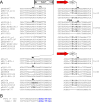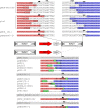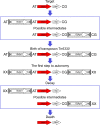The Birth and Demise of the IS Apl1- mcr-1-IS Apl1 Composite Transposon: the Vehicle for Transferable Colistin Resistance
- PMID: 29440577
- PMCID: PMC5821093
- DOI: 10.1128/mBio.02381-17
The Birth and Demise of the IS Apl1- mcr-1-IS Apl1 Composite Transposon: the Vehicle for Transferable Colistin Resistance
Abstract
The origin and mobilization of the ~2,609-bp DNA segment containing the mobile colistin resistance gene mcr-1 continue to be sources of uncertainty, but recent evidence suggests that the gene originated in Moraxella species. Moreover mcr-1 can be mobilized as an ISApl1-flanked composite transposon (Tn6330), but many sequences have been identified without ISApl1 or with just a single copy (single ended). To further clarify the origins and mobilization of mcr-1, we employed the Geneious R8 software suite to comprehensively analyze the genetic environment of every complete mcr-1 structure deposited in GenBank as of this writing (September 2017) both with and without associated ISApl1 (n = 273). This revealed that the 2,609-bp mcr-1 structure was likely mobilized from a close relative of a novel species of Moraxella containing a chromosomal region sharing >96% nucleotide identity with the canonical sequence. This chromosomal region is bounded by AT and CG dinucleotides, which have been described on the inside ends (IE) of all intact Tn6330 described to date and represent the ancestral 2-bp target site duplications (TSDs) generated by ISApl1 transposition. We further demonstrate that all mcr-1 structures with just one ISApl1 copy or with no ISApl1 copies were formed by deletion of ISApl1 from the ancestral Tn6330, likely by a process related to the "copy-out-paste-in" transposition mechanism. Finally, we show that only the rare examples of single-ended structures that have retained a portion of the excised downstream ISApl1 including the entire inverted right repeat might be capable of mobilization.IMPORTANCE A comprehensive analysis of all intact mcr-1 sequences in GenBank was used to identify a region on the chromosome of a novel Moraxella species with remarkable homology to the canonical mcr-1 structure and that likely represents the origin of this important gene. These data also demonstrate that all mcr-1 structures lacking one or both flanking ISApl1 were formed from ancestral composite transposons that subsequently lost the insertion sequences by a process of abortive transposition. This observation conclusively shows that mobilization of mcr-1 occurs as part of a composite transposon and that structures lacking the downstream ISApl1 are not capable of mobilization.
Keywords: colistin resistance; composite transposon formation; drug resistance evolution; insertion sequence; transposon decay.
Copyright © 2018 Snesrud et al.
Figures









Similar articles
-
A Model for Transposition of the Colistin Resistance Gene mcr-1 by ISApl1.Antimicrob Agents Chemother. 2016 Oct 21;60(11):6973-6976. doi: 10.1128/AAC.01457-16. Print 2016 Nov. Antimicrob Agents Chemother. 2016. PMID: 27620479 Free PMC article.
-
In Vitro Study of ISApl1-Mediated Mobilization of the Colistin Resistance Gene mcr-1.Antimicrob Agents Chemother. 2017 Jun 27;61(7):e00127-17. doi: 10.1128/AAC.00127-17. Print 2017 Jul. Antimicrob Agents Chemother. 2017. PMID: 28416554 Free PMC article.
-
Intracellular Transposition of Mobile Genetic Elements Associated with the Colistin Resistance Gene mcr-1.Microbiol Spectr. 2023 Feb 14;11(1):e0327822. doi: 10.1128/spectrum.03278-22. Epub 2022 Dec 13. Microbiol Spectr. 2023. PMID: 36511714 Free PMC article.
-
The insertion sequence excision enhancer: A PrimPol-based primer invasion system for immobilizing transposon-transmitted antibiotic resistance genes.Mol Microbiol. 2023 Nov;120(5):658-669. doi: 10.1111/mmi.15140. Epub 2023 Aug 13. Mol Microbiol. 2023. PMID: 37574851 Review.
-
Updates on the global dissemination of colistin-resistant Escherichia coli: An emerging threat to public health.Sci Total Environ. 2021 Dec 10;799:149280. doi: 10.1016/j.scitotenv.2021.149280. Epub 2021 Jul 27. Sci Total Environ. 2021. PMID: 34364270 Review.
Cited by
-
Global epidemiology, genetic environment, risk factors and therapeutic prospects of mcr genes: A current and emerging update.Front Cell Infect Microbiol. 2022 Aug 26;12:941358. doi: 10.3389/fcimb.2022.941358. eCollection 2022. Front Cell Infect Microbiol. 2022. PMID: 36093193 Free PMC article. Review.
-
A unique eukaryotic lineage of composite-like DNA transposons encoding a DDD/E transposase and a His-Me finger homing endonuclease.Mob DNA. 2022 Oct 22;13(1):24. doi: 10.1186/s13100-022-00281-3. Mob DNA. 2022. PMID: 36273192 Free PMC article.
-
Comparative Genome Analysis of Livestock and Human Colistin-Resistant Escherichia coli Isolates from the Same Household.Infect Drug Resist. 2021 Mar 3;14:841-847. doi: 10.2147/IDR.S298120. eCollection 2021. Infect Drug Resist. 2021. PMID: 33688219 Free PMC article.
-
Global Burden of Colistin-Resistant Bacteria: Mobilized Colistin Resistance Genes Study (1980-2018).Microorganisms. 2019 Oct 16;7(10):461. doi: 10.3390/microorganisms7100461. Microorganisms. 2019. PMID: 31623244 Free PMC article.
-
Characterization and Comparative Genomics Analysis of lncFII Multi-Resistance Plasmids Carrying bla CTX - M and Type1 Integrons From Escherichia coli.Front Microbiol. 2021 Nov 16;12:753979. doi: 10.3389/fmicb.2021.753979. eCollection 2021. Front Microbiol. 2021. PMID: 34867876 Free PMC article.
References
-
- Siguier P, Gourbeyre E, Varani A, Ton-Hoang B, Chandler M. 2014. Everyman’s guide to bacterial insertion sequences, p 555–590. In Craig NL, Chandler M, Gellert M, Lambowitz AM, Rice PA, Sandmeyer SB (ed), Mobile DNA III, 3rd ed. ASM Press, Washington DC.
Publication types
MeSH terms
Substances
LinkOut - more resources
Full Text Sources
Other Literature Sources
Medical
Molecular Biology Databases

